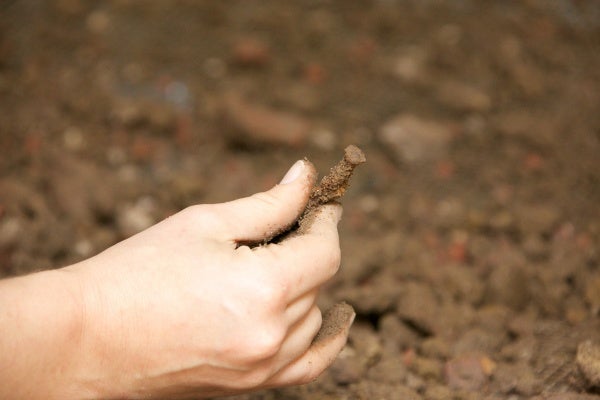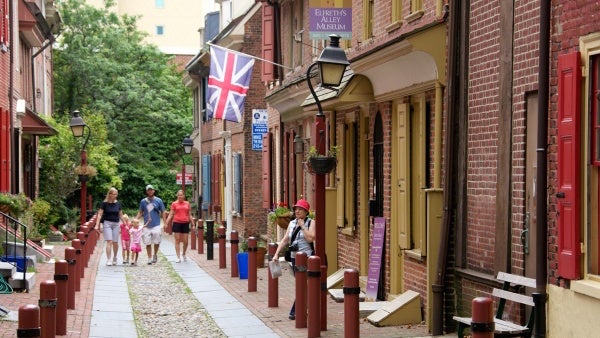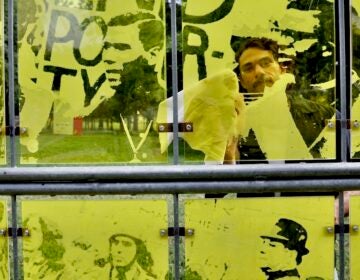Elfreth’s Alley backstory yields clues to life of Philly immigrants
Here are some of the 6,000 objects Deirdre Kelleher has dug up in the lot behind the Elfreth’s Alley Museum: Clay marbles. Buttons. Goat bones. Oyster shells. Nineteenth-century foundation walls. Rusty pieces of oddly shaped metal. Shards of ceramic Staffordshire slipware. A nearly complete gilt-edged, hand-painted china teacup. Small bits of clear plastic. Styrofoam. Broken safety glass. Crushed red brick. More than 800 nails.
“Nails are datable,” said Kelleher, a doctoral candidate in archaeology at Temple University. “There are wire nails, machine-head nails, rosehead nails. They help us tell time.”
This is the second summer Kelleher has dug holes behind the quaint, Colonial rowhomes along the oldest residential neighborhood in America. Most of the people living along the cobblestone street can trace previous homeowners back 300 years. It’s an extremely well-documented neighborhood.
However, not much is known about the tenement housing where immigrant laborers lived directly behind those houses.
Tenement located behind Elfreth Alley homes
“The Philly tenement isn’t like the tenement structures of other big cities like New York or Boston, with high-rises that were on display and the poverty was easily visible,” said Kelleher. “Philly was known as the ‘city of homes.’ On the street side, you had these cute little houses, but in the back lots you had crumbling structures.”
To find clues to how those poorer families lived, Kelleher is using amateur archaeologists with little or no training. History enthusiasts eager to dig through 200-year-old trash volunteered via an open, online signup process, arriving with little more than curiosity and sturdy pair of jeans.
“I love public archaeology,” said Kelleher. “Elfreth’s Alley is a street with so many different people. I’m looking at immigrants. It’s important to allow people to get involved with history.”
Phillipe Atallah, a rising sophomore at Penn Charter High School and a self-described history buff, stumbled on the opportunity during a visit to Elfreth’s Alley with his mother. Since then, he has dug up relics here twice already.
“Getting your hands dirty is fun,” said Phillipe. “I find it’s really fun to pick up stuff that somebody 100 years ago picked up and was using.”
Phillipe might go one step further and start analyzing what he finds. Kelleher is also using volunteers to do the more delicate work of cleaning, sorting, and identifying unearthed material. The rule of thumb in archaeology dictates that for every one day of digging there are 10 days of lab work.
Digs draw lots of volunteers, history buffs
However laborious the work might be, Kelleher is fully booked with people who want to be part of it.
“It’s never an issue of finding people who want to get dirty,” said Kelleher, who will study the objects for her dissertation.
The site of the dig is owned by the Elfreth’s Alley Association. It is partially bricked over as a patio, normally used in the summertime for public events and performances. The archaeology project makes that impossible. A green plastic fence keeps visitors a safe distance from the grid of holes and stakes marking dig sites.
However it might disrupt Elfreth’s Alley Association’s programming, president Edward Mauger applauds Kelleher. “No other place in America celebrates three centuries of the skilled and factory workers,” he wrote in an email. “The more we learn, the better we can acknowledge the lives of the people who formed the nation’s unique, multicultural experiment.”
Some objects Kelleher dug up in the back yard are on display in the Elfreth’s Alley Museum‘s exhibition, “Making Ends Meet: 300 Years of Life on Elfreth’s Alley.”
WHYY is your source for fact-based, in-depth journalism and information. As a nonprofit organization, we rely on financial support from readers like you. Please give today.









